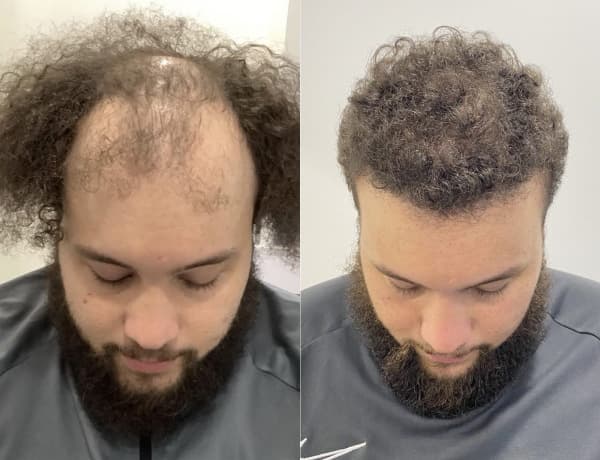Hair transplant density refers to how full the hair looks after a procedure. At Trichogenics, founded by Dr. Asi and Eric Peretz, patients receive advanced care designed to match natural hair patterns. Our clinic operates legally in Greece and Israel, unlike Turkey, where many clinics lack regulation and safety standards.
Key Takeaways
- Hair transplant density refers to the number of hair follicles placed per square centimeter, which directly influences the appearance of the hair after surgery.
- Most patients achieve natural-looking results at 40–60 follicular units per cm2, but hair type and donor supply affect what is realistically possible.
- Choosing an experienced surgeon is essential to avoid overharvesting, poor graft survival, and long-term damage, especially when considering unregulated clinics in Turkey.
- Techniques such as angled placement, follicular unit selection, and supportive treatments help increase visual fullness without overcrowding the scalp.
What Is Hair Transplant Density?

Hair transplant density measures how many hair follicles are placed per square centimeter. This number influences how thick the hair appears after surgery. Reaching natural hair density is the goal, without damaging the scalp.
What Is a Good Density for a Hair Transplant?
A good density for most patients ranges between 40 and 60 follicular units per cm2. This range can create a natural look without stressing the donor area. Surgeons also consider hair color, diameter, and growth direction to avoid artificial results.
High-Density Hair Transplant Overview
A high-density hair transplant aims to create the appearance of maximum fullness. It requires strategic planning and proper spacing to protect transplanted hair. Working with an experienced surgeon helps prevent issues associated with overcrowding.
What Is the Highest Density Hair Transplant?
The highest density hair transplant depends on donor supply and scalp health. Some patients can safely achieve higher densities if their donor site has strong follicular units. Your doctor must evaluate this before surgery.
Hair Transplant Density cm2 Explained
Density measurements in cm² help surgeons determine the amount of hair needed for each section. Thick hair strands provide greater coverage with fewer units. This metric guides the distribution of grafts during hair transplantation.
Hair Transplant Density Comparison
Comparison charts help patients understand differences between densities.
For example:
- 30–40 units: light coverage
- 40–50 units: natural coverage
- 50–60 units: fuller hairline
These benchmarks support realistic expectations.
Factors That Affect Density Results
Multiple biological factors influence density. Thick hair creates better shadow effects on the scalp. The patient’s age and hair loss pattern also play a role.
Donor Area Limitations
The donor area contains limited donor hair and cannot be overused. Overharvesting creates visible thinning in the back of the head. Unsafe clinics in Turkey often ignore these limits.
Density Goals by Hair Type
Hair type affects how much coverage patients need. Curly or dark hair can create density illusions in a bald area. This helps reduce the number of grafts required.

Density Needs by Bald Areas
Patients can improve results by following simple preparation steps. These actions support healthy blood flow and scalp condition before surgery.
Helpful preparation tips include:
- Avoid smoking for at least two weeks before the procedure
- Limit alcohol consumption to reduce inflammation
- Improve sleep to support recovery
- Wash the scalp gently without harsh products
These habits create a healthier foundation for transplanted hair.
Natural vs. Maximum Density
There is a difference between natural density and maximum capacity. Natural placements prevent damage and maintain blood supply. Maximum density attempts can compromise graft survival.
Risks of Overharvesting
Overharvesting reduces healthy donor supply and harms appearance. It also weakens the donor site. Many patients who travel to Turkey suffer this issue due to lack of medical oversight.
Techniques to Increase Density
FUE hair transplant methods enable surgeons to place grafts with precision. This surgical technique protects the scalp and avoids compression damage. Proper spacing supports long-term survival.
Thick Hair Transplant Benefits
A thick hair transplant can produce strong visual density with fewer units. Patients with thicker strands require less hair to achieve coverage. This protects the donor supply.
Follicular Units vs. Individual Hairs
A follicular unit may contain multiple hairs. Surgeons use single hairs for the hairline and multiple units behind it. This layering creates natural transitions.
Hair Follicle Survival Rates
Follicle survival rates depend on handling and blood supply. High survival rates mean increasing hair density without increasing the risk. Expertise improves this outcome.
Visual Density Illusion Techniques
Angled placement creates a shadow that adds visual fullness. Strategic layering enhances coverage without requiring additional grafts. This technique is useful in the crown and mid-scalp.
Number of Grafts Required
The number of grafts required varies by patient. Larger bald areas demand more units to achieve coverage. Surgeons calculate this based on donor supply and long-term planning.
@trichogenics How dense do you actually need your hair transplant to be? #trichogenics #hairtransplant #hairtransplantturkey #hairtransplantgreece #hairloss #hairfall #fyp #fue #hairtransplantjourney #hairfallsolution #hairtransplantation
♬ original sound - Trichogenics
Expected Results After Surgery
Results improve gradually across several months. Early shedding is normal and part of the healing cycle. Final outcomes appear between 9 and 12 months.
Healing Timeline and Growth Stages
Healing takes place over multiple phases. Patients see growth at month three, and density improves over time. Long-term improvements help overall fullness.
Realistic Density Expectations
Not every patient can achieve maximum density due to biological limitations. Surgeons set expectations to protect the donor area. This helps prevent disappointment.
Maintenance Treatments for More Density
Treatments like minoxidil support growth after surgery. These can add thickness to transplanted hair. They improve the perception of density post-transplant.
Choosing the Right Surgeon
Choosing the right surgeon prevents complications. Dr. Asi Peretz specializes in advanced hair transplant surgery with safe planning. Avoid unregulated clinics that risk long-term damage.
Experience and Skill Requirements
Skill affects hair placement accuracy. Poor spacing leads to low density and poor survival. Surgical technique matters as much as donor supply.
Hair Transplant for Density Candidates
Ideal candidates have stable hair loss and a healthy donor site. They must also have realistic goals. A medical evaluation is necessary before undergoing surgery.
Post-Transplant Density Care Tips
A few mistakes can lower hair follicle survival and reduce visual density. Patients should avoid certain habits to protect newly transplanted hair.
Common mistakes to avoid include:
- Scratching or rubbing the scalp
- Direct sun exposure during early healing
- Heavy exercise in the first week
- Wearing helmets or tight hats that cause friction
Avoiding these actions supports healthier outcomes.
Potential Risks and Complications
Typical complications include redness, swelling, or uneven growth. In countries without regulation, the risk of infection increases. Greece and Israel offer safer medical environments compared to Turkey’s low oversight.
Making an Informed Decision

Hair density affects how natural a result looks after a transplant. With proper planning and care, patients can achieve strong visual coverage while protecting donor supply.
Working with regulated clinics like Trichogenics ensures safety, expert guidance, and healthier results.



